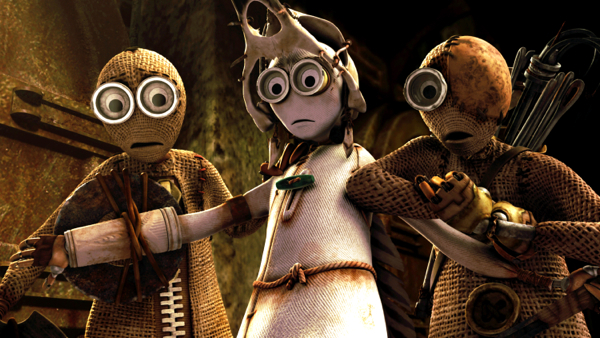Movie review by Greg Carlson
The expanded version of Shane Acker’s 2005 computer animated short “9” bears many unwelcome traits that can accompany movies making the leap to feature length, most notably the change from silent protagonists to celebrity-voiced chatterboxes. Despite the detailed look of the film’s post-apocalyptic, industrial wasteland, “9” struggles to apply the same level of creativity to its storyline as it does to what Acker calls its “stitchpunk” characters. Only the most devoted animation and science fiction fans will forgive the movie’s narrative resemblance to “The Lord of the Rings” and scripter Pamela Pettler’s appallingly feebleminded dialogue, which constantly tarnishes the imaginative capability of the film’s otherworldly landscapes.
Elijah Wood plays the title figure, a zippered cloth ragdoll with an expressive mouth and blinking diaphragm shutters in his goggle eyes. The last in a line of increasingly augmented homunculi, 9 clashes with the conservative 1 (Christopher Plummer), a wizened ecclesiast who resembles the vaguely amphibious Nute Gunray from the “Star Wars” prequels. Along with devoted sidekick 5 (John C. Reilly), 9 ventures forth to uncover the secrets of his origin and the function of a mysterious talisman. The journey is fraught with peril, and 9 is aided on his quest by the rebellious 7 (Jennifer Connelly), whose fearlessness inspires 9 as much as it terrifies 1.
The vistas and objects of “9” radiate with a peculiar familiarity even as the filmmakers struggle to set them apart from their inspirations. The clever employment of everyday objects repurposed for use by miniature agents (i.e. a single scissor blade wielded as a sword) was a staple of centuries-old folktales of the “Tom Thumb” variety long before animators like Ub Iwerks, Walt Disney, and Chuck Jones delighted viewers with cartoon shorts depicting tiny heroes drinking from thimbles or shoveling soap flakes with teaspoons. This effect, which adds a great deal of color to “9,” can be traced to both vintage cartoons and more recent stop motion work, including Mark Gustafson’s 1994 “Mr. Resistor.”
“9” owes an even greater visual debt to Stephen and Timothy Quay, Fred Stuhr, and Tim Burton (one of the producers of “9”), especially in Acker’s affinity for nightmarish mechanical apparatuses with broken porcelain doll faces, sharp razors, and serpentine and arachnidan movements. The decimated landscape in which 9 and his companions struggle to survive may mirror the blighted ghost city of “WALL-E,” but the movies part company at this similarity. The ecological warning of the Pixar film is replaced with dire omens concerning artificial intelligence and technology run amok, ala “The Terminator.”
The crushing tedium of “9” manifests in the worthless banalities mouthed by its naïve, bullheaded characters and the endless cycle of chase and escape that eats up the rest of the screen minutes. Pettler, whose script for “Monster House” is substantially more refined than “9,” skips along the surface of several themes that could have addressed rich philosophical terrain. Instead of considering what it means to be alive or yearning to better understand their creator, the stitchpunks gush streams of moronic obviousness, presumably to explain the empty mythology that governs their world. “9” restages a number of scenes depicted in Acker’s Academy Award-nominated short film, but never improves upon them.
